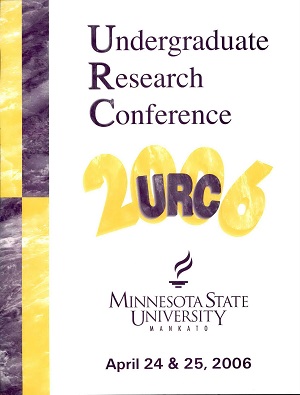The Influence of Kaolinite on the Fate of Erythromycin in Soil Environments
Location
CSU North Ballroom
Start Date
25-4-2006 10:00 AM
End Date
25-4-2006 12:00 PM
Student's Major
Chemistry and Geology
Student's College
Science, Engineering and Technology
Mentor's Name
Trent Vorlicek
Mentor's Department
Chemistry and Geology
Mentor's College
Science, Engineering and Technology
Description
This project seeks to quantify the loss of erythromycin, a common antibiotic for animals and humans, as well as identify any degradation products caused by the surface of kaolinite, a common clay mineral. Antibiotics are commonly introduced into soil environments by treatment plant effluent and agricultural runoff. The introduction of antibiotics is of particular concern because it may promote microbial resistance. Clay minerals are known to adsorb organic molecules and promote their degradation. In order to gain insight into the nature of the clay/erythromycin interactions, experiments are designed to quantify the loss of erythromycin to kaolinite under environmentally relevant conditions. Gas Chromatography (GC) will be used to quantify erythromycin losses and to indicate any degradation products facilitated by the clay surface. These data will be used to determine binding constants between the kaolinite and erythromycin. Gas Chromatography-Mass Spectrometry (GC-MS) will be used to identify any significant degradation products. Erythromycin was purchased commercially and recrystallized under various conditions using acetone. Currently, a GC method suitable for quantifying erythromycin is being developed.
The Influence of Kaolinite on the Fate of Erythromycin in Soil Environments
CSU North Ballroom
This project seeks to quantify the loss of erythromycin, a common antibiotic for animals and humans, as well as identify any degradation products caused by the surface of kaolinite, a common clay mineral. Antibiotics are commonly introduced into soil environments by treatment plant effluent and agricultural runoff. The introduction of antibiotics is of particular concern because it may promote microbial resistance. Clay minerals are known to adsorb organic molecules and promote their degradation. In order to gain insight into the nature of the clay/erythromycin interactions, experiments are designed to quantify the loss of erythromycin to kaolinite under environmentally relevant conditions. Gas Chromatography (GC) will be used to quantify erythromycin losses and to indicate any degradation products facilitated by the clay surface. These data will be used to determine binding constants between the kaolinite and erythromycin. Gas Chromatography-Mass Spectrometry (GC-MS) will be used to identify any significant degradation products. Erythromycin was purchased commercially and recrystallized under various conditions using acetone. Currently, a GC method suitable for quantifying erythromycin is being developed.
Recommended Citation
Erdmann, Leila. "The Influence of Kaolinite on the Fate of Erythromycin in Soil Environments." Undergraduate Research Symposium, Mankato, MN, April 25, 2006.
https://cornerstone.lib.mnsu.edu/urs/2006/poster-session-E/8



